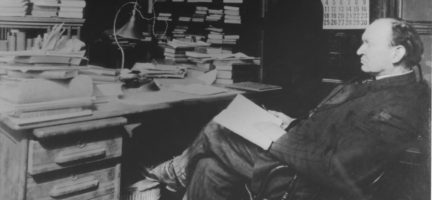
The Three Foot Manuscript
Dr. Stephen Nichols introduces us to A.T. Robertson and one of his monumental achievements: a 1500-page grammar of the Greek New Testament.
What is the three-foot tall manuscript? It was actually the handwritten manuscript for a book that was fifteen hundred pages. I don’t know if you’ve ever read a book that is fifteen hundred pages. It’s quite a feat. It is also a feat to write a book that’s fifteen hundred pages, and the manuscript behind that book was three feet tall. It was written by Archibald Thomas Robertson. A.T. Robertson was a professor at the Southern Baptist Theological Seminary in Louisville, Kentucky. This episode is recorded on location in Louisville, and we’re in the alumni chapel here on the campus of the Southern Baptist Theological Seminary.
 Who was A.T. Robertson, the man behind this three-foot tall manuscript? He was born in 1863 in Virginia, but he grew up in North Carolina. He studied at Wake Forest College, excelled at languages, received a master’s degree there, and then he went and studied at the Southern Baptist Theological Seminary in Louisville. Robertson graduated in 1888, and upon his graduation served for two years as a teaching assistant for John Broadus, who was the president of the seminary at the time. In 1890 he was appointed as an associate professor, in 1984 he married John Broadus’s daughter, and in 1895 he became a full professor.
Who was A.T. Robertson, the man behind this three-foot tall manuscript? He was born in 1863 in Virginia, but he grew up in North Carolina. He studied at Wake Forest College, excelled at languages, received a master’s degree there, and then he went and studied at the Southern Baptist Theological Seminary in Louisville. Robertson graduated in 1888, and upon his graduation served for two years as a teaching assistant for John Broadus, who was the president of the seminary at the time. In 1890 he was appointed as an associate professor, in 1984 he married John Broadus’s daughter, and in 1895 he became a full professor.
Robertson spent his decades at SBTS teaching students New Testament in Greek. On September 24, 1934, he was feeling a little ill. He collapsed in his classroom, and his students noticed that he was sweating profusely. He dismissed his class and a younger faculty member helped his seventy-year-old colleague make it to his home. There, later in the day, he died of a stroke. He spent his entire career at SBTS from when he graduated in 1888 until 1934.
Not only did he teach New Testament in Greek and other classes, but he wrote a total of forty-five books. The big monster, the fifteen-hundred-page book, was his Grammar of the Greek New Testament in Light of Historical Research. He also wrote the six-volume work Word Pictures in the New Testament. He wrote a little book called The Minister and His Greek Testament, and that really gets to the heart of what Robertson was about. Back in 1890, when he was appointed an associate professor, he gave a lecture at the seminary entitled “Preaching and Scholarship.” He believed that pastors should be scholars of the Greek text so they could be better preachers. At one point, he said:
“If theological education will increase your power for Christ, is it not your duty to gain that added power?”
He also at one time simply said, “My plea is for scholarship that helps men to preach.” That’s the kind of scholarship he was after. At one point, Robertson also quipped that “the greatest proof that the Bible is inspired is that it has survived so much bad preaching.”
Robertson devoted his life, teaching, and his work in his books to try to help men preach the Bible better, to know the Bible better, and to be better preachers. Dr. Al Mohler, the current president of the seminary where Robertson taught for decades, said of A.T. Robertson that his book and his work was a “monumental achievement pointing to the true essence of evangelical scholarship.”
That day in September of 1934, when A.T. Robertson had his stroke and died, he was actually looking over the Greek text of Matthew 6:11. We know this passage well, “give us this day our daily bread.” And so, A.T. Robertson spent a life of teaching ministers how to give to their congregation the bread of life.
Stay connected with 5 Minutes in Church History by getting the weekly podcast on iTunes, SoundCloud, or via RSS. You can also subscribe to the blog via RSS and follow us on Twitter and Facebook.
(This podcast is by Ligonier Ministries. Discovered by Christian Podcast Central and our community — copyright is owned by the publisher, not Christian Podcast Central, and audio is streamed directly from their servers.)